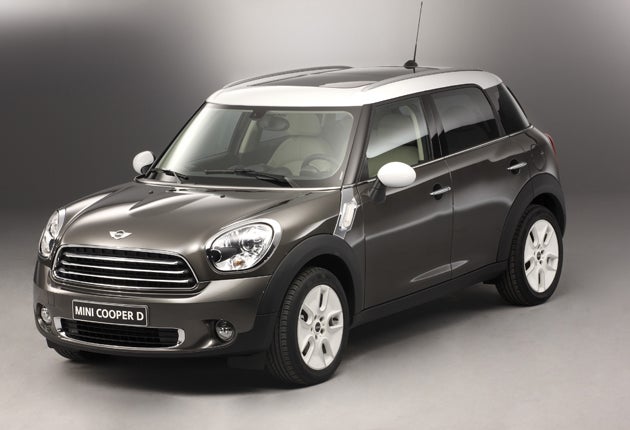Mini Countryman
The Countryman is a 1.4-ton cartoon giant

Your support helps us to tell the story
From reproductive rights to climate change to Big Tech, The Independent is on the ground when the story is developing. Whether it's investigating the financials of Elon Musk's pro-Trump PAC or producing our latest documentary, 'The A Word', which shines a light on the American women fighting for reproductive rights, we know how important it is to parse out the facts from the messaging.
At such a critical moment in US history, we need reporters on the ground. Your donation allows us to keep sending journalists to speak to both sides of the story.
The Independent is trusted by Americans across the entire political spectrum. And unlike many other quality news outlets, we choose not to lock Americans out of our reporting and analysis with paywalls. We believe quality journalism should be available to everyone, paid for by those who can afford it.
Your support makes all the difference.I used to own a Lotus Elan, the original from the 1960s.
I once parked it next to a current Mini, and the Mini loomed over it like an SUV. We all know that cars have got too big nowadays, and so-called superminis are nothing of the kind, but this particular juxtaposition was a stark revelation of size inflation.
So that little Elan had better stay well clear of the car you see here, in case it gets run over. This car really is a Mini SUV; it can even be had with a four-wheel drive system called ALL4. Its name is Countryman, that usual Austin designation for estate cars in years past, although there is none of the wooden adornment seen on the original. This time, though, Austin gives way to Austria for it is there, in the Magna Steyr factory, that the Countryman is built.
This is a cartoon car, an automotive comedy act. Its proportions are those of all Minis through the decades, so it has huge wheels (19in examples are an option), hefty headlights and a truly giant speedometer in the middle of the dashboard. This £22,000 Mini is as big as the old Austin Maxi, and somewhat heavier. Calling the new car Mini is necessary for visual and marketing reasons, but given that "Mini" alludes to small size it's close to oxymoronic.
Does this matter? Maybe only to people like me. The fact is that most people don't really notice this "size creep", instead merely liking the extra space and crash protection. Here, indeed, is the first truly roomy Mini, with four passenger doors, generous rear passenger space and a proper boot. The rear seats can be a pair of separate chairs or a three-seater bench. Both variations slide and fold, but with the separate seats comes a rearward extension of the metal rail system that runs along the cabin's centre line. It houses cupholders, sunglasses holders and other such lifestyle-enhancers.
If you see a Countryman heading towards you, you might think it a regular Mini that's a bit nearer. The person driving it will feel different sensations, however. Its creators have tried to keep some recognisable Mini-ness in the driving qualities, because anything that's called Mini should be as agile as a car can be, but there's only so much bending that the laws of physics will allow.
The steering is very quick to respond, which gives an initial impression of friskiness, but otherwise the Countryman simply grips firmly and sticks doggedly to its path. As for the electric power steering, switched to sport mode it is really quite unpleasant. Better to leave it in the normal setting, in which the weighting is more credible and your wrists won't ache.
All that said, the 1.6-litre turbo engine in the Cooper S ALL4 – the only version so far available to test – is an excellent unit, now with throttle-less Valvetronic camshaft control for greater efficiency and a 184bhp power output. It pulls strongly and smoothly, although this version's near-1.4 ton mass blunts the pace compared with a normal-size Cooper S. Be careful with the six-speed gearchange, though – it's easy to select reverse instead of first, and embarrassing when you do.
Other engines to come include a diesel with a choice of two power outputs and a non-turbo version of the petrol 1.6. Only the more powerful engine of each fuel type can be had with ALL4, a system that diverts all the engine's efforts exclusively to the rear wheels should the fronts lose grip.
So, can you ever believe you're driving a Mini when it's a Countryman? You can, eventually; the visual cues are too strong not to. That giant speedometer, the shape of the windscreen, the view down the bonnet, they all suck you in. Soon you'll even be able to bask in some rally heritage, just as in the old days, because red Countryman rally cars with white roofs are in the World Rally Championship.
That pleases car nuts like me, but I suspect most buyers will be more taken by the optional Mini Connected system which sucks your iPhone's brain into the car's own menu-driven, on-screen control system. It's a remarkable piece of electronic integration.
And that, today, is what people want. For me, the Mini Countryman is a flawed concept. For the people at whom it's aimed, it's bang on target.
The Rivals
Kia Soul Burner 1.6 CRDi: £16,595.
Much cheaper, but chasing a similar youth market with its rugged looks. Good diesel engine.
Skoda Yeti 1.8 TSI 4WD Elegance: £21,510.
An IoS favourite, here with top equipment, fine turbo petrol engine. Great fun to drive.
Volkswagen Golf 1.4 TSI GT 5dr: £20,825. Not quite a GTI, but still has 160bhp.
Practical, entertaining; the mainstream alternative.
Join our commenting forum
Join thought-provoking conversations, follow other Independent readers and see their replies
Comments